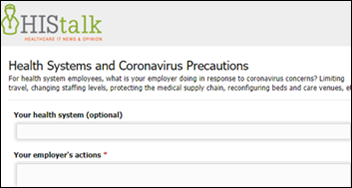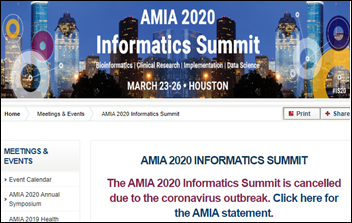My survey question: What impact will the conference’s cancellation have on your organization, in terms of expense, strategy, marketing, etc.?
Looking to the positive innovation that can come from this crisis. We all have our HIMSS routine and must get creative this year to turn this negative into the next generation. Whether it be virtual solutions, care management platforms, or new ways to connect and learn from each other, now is the time. New ways of working are essential. HIMSS in its current form may be the old model. Excited to design the future.
Will definitely reduce investment for any other conferences for remainder of 2020. It was laughable that HIMSS sent an email to us this week asking if we wanted to meet to discuss exhibiting at Health2.0 in the fall. Unlikely, on the heels of us wasting >33% of our promotion budget on HIMSS20. This is much harder on small to medium companies like ours. Which is why big companies could drop out, but not small.
I will be very interested to see how this plays out contractually — refunds, HIMSS points, etc. It would be nice if HIMSS found a way to reward those of us who remained committed up to cancellation — perhaps those who pulled out lose 50% of their HIMSS points, or something.
Rescheduling high value meetings is the first priority. Prior to HIMSS officially cancelling, about half of our meetings had cancelled on their own (and we were on the cusp of just pulling out all together) so that process had already begun, but logistically it will not be without challenges.
Figuring out what / how we will be reimbursed. Besides HIMSS sponsor / booth costs and the associated hotel costs, there’s also misc vendor costs that we contract for separately (build, hardware, set up etc.). I’m guess we’re SOL on those, but the hardest part is just not knowing what HIMSS will do as we await their “14 business days” to figure it out.
Generally deciding if we’re going to sponsor HIMSS going forward. For one, I’m very concerned about their long-term financial viability following this unfortunate series of events, and two, could this be the year vendor marketing execs decide enough is enough with the exorbitant exhibitor costs and take that $$$ for something else?
Frankly, we are trying to figure that out. We weren’t told yet what refunds are available for hotel rooms for example. We had an expensive event scheduled and aren’t sure yet how they will work with us on cancellation at the venue. Airfares are the worst –change fees at best. It’s a real financial loss.
Simply put, it’s devastating. In stark reality, some individuals at my company will lose their jobs. HIMSS represents a significant portion of our overall strategy, so the direct impact to sales and budget isn’t recoverable this year. I am likely to be one of those individuals.
Months of planning and work has been lost, with only limited elements able to be reconfigured for digital or virtual consumption within the small window of time HIMSS attendees’ attention will turn to #virtualHIMSS20, not to mention the lack of budget available to spend on the digital promotion required to capture that attention. Similarly, HIMSS is where we conduct a signification portion of partner networking at scale, which has been completely wiped out.
It is completely unclear if any sunk costs will be refunded and the likelihood of other upcoming healthcare conferences — such as ACHE Congress and Beckers — being cancelled means additional devastation for our company’s budget and ability to make sales this year. Because the cancellation came so very late, the vast majority of our expense cannot be recovered in any way and it’s unlikely new revenues will be generated in time to keep our 2020 strategy from collapsing.
While trying to keep perspective and recognizing first that we must do no harm in healthcare, today was especially hard and the situation is now bleak.
We’re rallying to host as many of our scheduled events as online options during the original event days. We want to make good use of the time and expense paid to prepare, regardless of sponsorship fees that are in flux.
BizDev outreach becomes MUCH more costly for small / medium businesses if we have to travel prospect by prospect.
It was tough to find out we aren’t able to share with and learn from so many others face-to-face in Orlando this year. That being said, we fully appreciate the willingness of HIMSS and its supporting sponsors and vendors to put public safety first, and ultimately, do the right thing.
One of the many traits I love about healthcare is that it fosters a never-ending conversation through seemingly infinite channels. Speaking for our company, we’re more excited than ever to actively participate in those conversations around improving the patient journey across all touch points for hospitals and health systems—whether that’s in the exhibit hall, through digital programs, or in the media. And when we do connect, we’ll have the “HIMSS20 that never was” as common ground.
Clearly 90% of the expense of HIMSS will be non-refundable and it will deliver 0% of its already-questionable value.
As a software vendor, IMO, the ROE on HIMSS is always questionable. We’ve been exhibiting at HIMSS for 20 years and ultimately decided that we could find value in the show two ways: 1) visiting with existing customers; and 2) guiding well-known, already-engaged prospects just a bit further towards a decision. The neophyte exhibitors show up with their order pads ready to go, thinking they will find new, qualified prospects and actually close business. With a typical 6-to-72 month sales cycle for healthcare software, at best new vendors will find a few folks kicking tires and they can fill the very top part of the sales funnel with the quality of leads likely not much better than an electronic form on their website saying, “Contact us to learn more about our solution.” Why else attend every year?
As a very long-term vendor with Round 1 booth selection priority, the HIMSS policy of “points reset” if you skip a year is the death knell for future years. Meaning, skip HIMSS once and you lose all of your seniority. Moving to the back of the line for booth location would make the entire show ROE much worse. Being on the main aisle next to the big boys dramatically helps in trying to find a few unknown prospects. As you often say, HIMSS is a boat show paid for by exhibitors and enjoyed by attendees as a chance to network. With the HIMSS organization so deeply dependent on the show for revenue, I expect there will be some very difficult business decisions for them in the near future.
We have mixed feelings about the cancellation of HIMSS20. On one hand, we’re disappointed that we won’t see our good friends, clients, colleagues, and competitors as we all gather to make the state of healthcare even better. We’re also disappointed that we won’t be able to showcase our latest innovations that we were excited to share and have spent lots of time and money getting ready to showcase. On the other hand, we’re grateful that HIMMS has taken this bold step to keep everyone safer.
The financial impact is high in terms of investment — both financial and the investment of time of our resources — all of which to date is not recoverable. We will wait the 14 days to see what HIMSS will do in terms of booth electrical, rigging, hanging sign, utilities as well as registrations and booth space. I suspect they will defer it all to next year, which is a great solution for them and cuts down on the administrative overhead, but for those already deciding not to go next year, this is not optimal.
It’s a double whammy. Lack of lead generation + costs we can’t recover.
We had spent the last 3-4 days “figuring out how to make lemonade” in terms of a smaller audience. Because we do a lot of business with other vendors, we had an opportunity to focus on those vendors (probably similar in size to us) that did attend.
Costs for sure we won’t recover: 1) Marketing contractor expense for the year-long HIMSS 2020 planning activities. 2) Cost of new banners / signage this year. Really glad we didn’t go with those expensive light boxes! 3) Shipping costs for booth furnishings. 4) Hotel / flights? We had access to a separate condo and were told that WILL be refundable. So that is some positive news.
That being said, I think it was the right call. I just wish they’d made the call sooner when honestly many of us felt this was going to be the eventual outcome. Those few days of delay cost us several thousand dollars on top of all the other unrecoverable expenses. Hoping that booth fees are rolled over to next year. If we can’t get booth fees credited or rolled over, we will very likely not do a booth next year at all.
We are ultimately happy with the decision to cancel. It was an inevitable public health risk, so we feel relieved for the Orlando community, attendees, fellow exhibitors, and our own team members.
The big loss from not having HIMSS is the industry impact. The conference typically sets the major trends for the year for health IT. It’s also our big opportunity to see diverse provider organizations face to face to hear their pain points and be inspired for innovation to address them. We need to take the momentum going into HIMSS20 planning and put that toward how we can directly impact this massive public health crisis.
We did not invest a lot this year, so not much sunk cost loss. We were going to present in a partner booth and am thinking about taking advantage of the open calendar to do a webinars instead. I expect we will have a similar sized audience with ability to share, record, promote, etc. So for us, small vendor, little impact.
HIMSS is the ONLY organization that demands full pre-payment of each exhibitor’s entire hotel reservation. We do not yet know what HIMSS and the hotels will do with these funds for folks who have not yet arrived. Installation staff (MarCom, tech) who are already on site are being told that, even though they have used two room nights– the industry-standard room night deposit– by checking out early, they will forfeit the complete prepaid amount. For a some of our staff, that is five to eight room nights wasted, at $175 per night plus tax. We are being told there is no option to reschedule use of those room nights.
No other conference group, not RSNA, not ACC, etc. instructs the housing bureau to instate such a money-banking policy. The money for entire hotel stays, not standard two nights, has been in HIMSS hands for months, behaving like a financial institution rather than a health industry association. This is simply an unnecessary hardship to foist on the exhibitors who fund these meetings, and an unseemly way for HIMSS to earn some interest.
Working to recreate the types of important feedback and research that we were going to conduct from a product perspective. A lot of this is solvable, but don’t have a great way to recreate the experience of someone walking up and having the type of unstructured interactions that HIMSS affords.
We used to be one of the top 20 exhibitors in terms of space (cost). We stopped exhibiting a few years ago and scaled back our attendees to less than 10. We have found the conference too big, too broad, and unproductive in generating real leads. This year for us, the impact of a cancelled HIMSS is likely some lost travel expenses.

























































All pretty nonspecific, but thank you for correctly saying “grudgingly” and not “begrudgingly”.